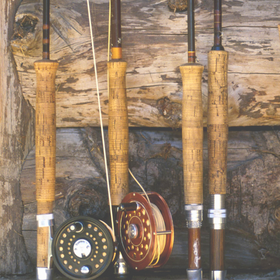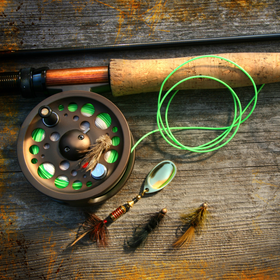Under fished compared to many East Coast fisheries, the Central California beach offers a varied and unpressured expanse of fly fishing. In many ways it also proves to be symbiotic with those with primarily trout skills. You can use a light set up, sizes 4-8 unweighted flies, and strip techniques similar to the trout experience. To the experienced saltwater fisher the California coast might look like a vast wasteland void of any tells that one is used to looking for.
But let’s start small with Jack Smelt and Surf Perch. All one really needs to do is look for swirling fish while walking the beach with a light rod in hand, as light as 4 wt. up to 6 wt. is good. When the surf is below 2 feet, keep your eyes out a few feet beyond the shoreline, once you spot the feeding frenzy; skate your fly across the surface and watch the chaos begin. These fish are not big as evidenced by the gear, but they hit hard and are torpedoes once hooked. They gather as the high tide ebbs to feed on sand flies and sand hoppers washed off of the high tide debris where they were feeding.
Some pre-fishing scouting can be done just by taking a stroll and looking for abundance of weed mass or carcasses; they are to the flies that eventually will feed the schools of fish once the high tide washes them out.
This is a fun way to introduce yourself to saltwater fly fishing as you are able to catch many fish; use light gear and skate flies to already feeding fish.
There are other techniques and species to target as well, including everyone’s favorite, the Striped Bass. The intertidal zone is home to the sand crab, which are easily identifiable. Sand crab ‘cities’ are numerous and relatively easy to spot; again by just strolling along the beach. The intertidal zone is the roiling mass of turbid waters between high tide and low tides. If you stop and look closely you can see the crabs do not stay put once anchored in the sand. But move a few feet and then re-anchor themselves, as they change feeding lanes with the outgoing tides. It is during this movement like an emerging insect they become vulnerable to stripers. Casting to stripers requires stealth techniques, starting with extremely cautious approach, your footsteps can and will spook them to deeper water. Often times you can glimpse them, which adds to both your excitement and need for even more caution. For sight casting position yourself so the crab pattern moves away from the fish when being stripped, use six inch strips to mimic actual crab movement. Usually within a few casts you either have attracted a strike or realize they are on to you, and need to move to a new location.
Stripers require heavier gear as the average weighs up to 5 pounds, although there are larger ones. Think 7-8 wt. range with a 15 pound leader, and be prepared for them to run well beyond the surf line.
But let’s start small with Jack Smelt and Surf Perch. All one really needs to do is look for swirling fish while walking the beach with a light rod in hand, as light as 4 wt. up to 6 wt. is good. When the surf is below 2 feet, keep your eyes out a few feet beyond the shoreline, once you spot the feeding frenzy; skate your fly across the surface and watch the chaos begin. These fish are not big as evidenced by the gear, but they hit hard and are torpedoes once hooked. They gather as the high tide ebbs to feed on sand flies and sand hoppers washed off of the high tide debris where they were feeding.
Some pre-fishing scouting can be done just by taking a stroll and looking for abundance of weed mass or carcasses; they are to the flies that eventually will feed the schools of fish once the high tide washes them out.
This is a fun way to introduce yourself to saltwater fly fishing as you are able to catch many fish; use light gear and skate flies to already feeding fish.
There are other techniques and species to target as well, including everyone’s favorite, the Striped Bass. The intertidal zone is home to the sand crab, which are easily identifiable. Sand crab ‘cities’ are numerous and relatively easy to spot; again by just strolling along the beach. The intertidal zone is the roiling mass of turbid waters between high tide and low tides. If you stop and look closely you can see the crabs do not stay put once anchored in the sand. But move a few feet and then re-anchor themselves, as they change feeding lanes with the outgoing tides. It is during this movement like an emerging insect they become vulnerable to stripers. Casting to stripers requires stealth techniques, starting with extremely cautious approach, your footsteps can and will spook them to deeper water. Often times you can glimpse them, which adds to both your excitement and need for even more caution. For sight casting position yourself so the crab pattern moves away from the fish when being stripped, use six inch strips to mimic actual crab movement. Usually within a few casts you either have attracted a strike or realize they are on to you, and need to move to a new location.
Stripers require heavier gear as the average weighs up to 5 pounds, although there are larger ones. Think 7-8 wt. range with a 15 pound leader, and be prepared for them to run well beyond the surf line.




